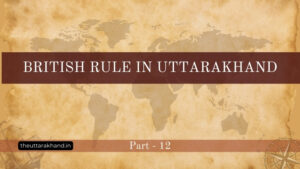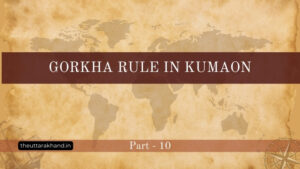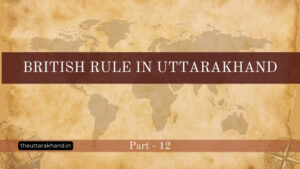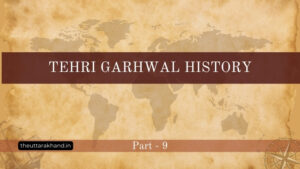British Rule in Uttarakhand – II
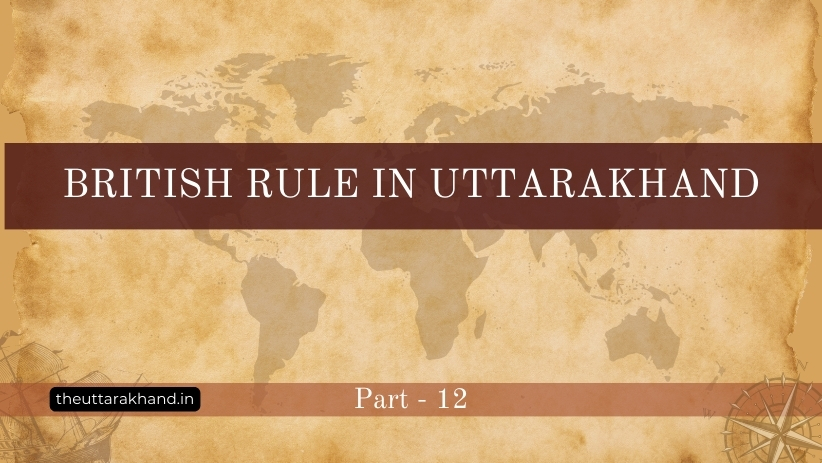
British Rule in Uttarakhand - II
Introduction to British Rule in Uttarakhand – II
British Rule in Uttarakhand – II : Uttarakhand, formerly known as Uttaranchal, is a state located in northern India, nestled amidst the majestic Himalayas. Rich in natural beauty and cultural heritage, this region has been inhabited since prehistoric times. However, it wasn’t until the mid-19th century when the British East India Company consolidated their control over the area, forming the divisions of Kumaun and Garhwal.
In this article, we will delve into the fascinating history of Uttarakhand, exploring how these two regions emerged and evolved over time, eventually culminating in the formation of the present day state.
II. Formation of the Kumaun and Garhwal Divisions
Establishment of the Hill States
Before the arrival of the British, Kumaun and Garhwal were comprised of numerous small hill states ruled by Rajput kings. These kingdoms often engaged in fierce battles against each other, vying for supremacy over the fertile valleys and strategic mountain passes. Despite the constant conflicts, these states managed to maintain a degree of autonomy and developed unique cultural identities that still exist today.
Arrival of the British
As the influence of the British East India Company expanded across India, they gradually turned their sights towards the strategically important hills of Kumaun and Garhwal. Following the Anglo-Nepalese War of 1814-1816, the British gained control over large portions of western Nepal, including parts of modern-day Kumaun. Realizing the potential benefits of governing these territories directly, the British proceeded to establish treaty relations with many of the neighboring hill states.
Consolidation of Power
Over the next few decades, the British continued to expand their sphere of influence in Kumaun and Garhwal, entering into agreements with additional hill states and incorporating new territories through conquest and purchase. By the mid-19th century, the British had effectively consolidated their hold over the region, dividing it into two distinct administrative units: the Kumaun Division and the Garhwal Division.
Administrative Structure
Under the British system, both divisions were governed by a commissioner who reported directly to the Lieutenant Governor of the North Western Provinces and later the United Provinces of Agra and Oudh. Each division was further divided into smaller districts, headed by deputy collectors and superintendents responsible for maintaining law and order, collecting revenues, and promoting economic growth.
Despite being administered separately, the Kumaun and Garhwal Divisions shared many similarities due to their geographical proximity and common historical roots. Both regions boasted stunning landscapes, ranging from verdant valleys to towering peaks, making them popular destinations for European travelers seeking adventure and spiritual enlightenment. Additionally, both Kumaun and Garhwal possessed vibrant cultures characterized by distinctive architectural styles, traditional music and dance forms, and colorful festivals celebrating regional mythologies and legends.
However, despite their shared qualities, there existed subtle differences between the two divisions that would ultimately shape their respective trajectories throughout the course of history. For instance, Kumaun enjoyed closer ties with neighboring plains regions such as Lucknow and Delhi, resulting in greater exposure to outside influences and cosmopolitan ideas. On the other hand, Garhwal remained relatively isolated, preserving many of its ancient traditions and customs intact.
III. Early Administrators
After the formal establishment of the Kumaun and Garhwal Divisions, the British appointed a series of administrators to manage these territories. While some were efficient and just rulers, others exploited the region for personal gains, causing widespread unrest among the local population. Nonetheless, these early administrators played crucial roles in shaping the socio-political landscape of Uttarakhand.
A) John Nicholson
John Nicholson served as the first Deputy Commissioner of Kumaun, arriving in Almora in 1815. An experienced military officer, he had previously fought alongside Lord Lake during the Battle of Deeg and the Siege of Bhurtpore. His primary objective in Kumaun was to strengthen British rule and improve communication networks with neighboring regions.
During his brief tenure, Nicholson initiated several infrastructure projects, including constructing roads, bridges, and rest houses. He also encouraged agriculture and trade, helping to revive the economy of the region. However, his authoritarian style and insensitivity towards local customs soon earned him the wrath of the inhabitants, leading to protests and demonstrations. Eventually, Nicholson was recalled to England after serving just eight months in office.
B) Frederick Young
Frederick Young succeeded John Nicholson as the Deputy Commissioner of Kumaun. Unlike his predecessor, Young adopted a conciliatory approach towards the local populace, respecting their customs and religious beliefs. He worked tirelessly to resolve disputes between communities and promoted education and healthcare initiatives.
Young’s most notable achievement was the codification of customary laws, which helped streamline judicial processes and reduce corruption within the administration. Moreover, he supported indigenous industries like wool production and pottery-making, fostering economic growth and job opportunities for the residents.
C) Henry Ramsay
Henry Ramsay assumed charge as the Commissioner of Kumaun in 1856, becoming one of the longest-serving administrators in the region’s history. With extensive experience in managing frontier provinces, Ramsay sought to bring peace and prosperity to Kumaun following the turbulent reign of his predecessors.
Ramsay focused on improving public services, investing heavily in infrastructure development, and introducing reforms designed to uplift marginalized sections of society. He founded schools, hospitals, and libraries, encouraging literacy and health awareness among the masses. Furthermore, he implemented policies aimed at conserving the environment, recognizing the importance of preserving the region’s fragile ecosystems.
Under Ramsay’s stewardship, Kumaun witnessed unprecedented progress and stability, earning him accolades from both the British authorities and the native population. To honor his contributions, the Kumauni community erected a statue of Ramsay in Almora, where it remains a symbol of gratitude and admiration.
IV. Demand for Separation from UP
By the late 19th century, demands for separation from the United Provinces (UP) began gaining traction among the people of Uttarakhand. Several factors contributed to this growing sentiment, chief among them being linguistic, cultural, and economic disparities between the hills and plains regions.
A) Language and Culture
Unlike the Hindi-speaking majority in the UP plains, the people of Uttarakhand predominantly spoke dialects derived from Sanskrit, such as Kumaoni and Garhwali. This linguistic divide resulted in poor communication and misunderstandings between the two regions, fueling discontent among the hill populations.
Moreover, the distinct cultural practices, folklore, and traditions prevalent in Uttarakhand contrasted sharply with those found in the plains. Festivals like Holi, Diwali, and Dussehra were celebrated differently in the hills, reflecting unique interpretations of age-old rituals and beliefs. The lack of appreciation for these distinctions further alienated the hill communities from their counterparts in the UP.
B) Economic Disparities
Economic exploitation of the hills by the plains also played a significant role in driving the separatist movement. Due to the steep terrain and harsh climate, agriculture in Uttarakhand was largely subsistence-based, offering little scope for commercialization. Meanwhile, the resource-rich plains attracted heavy investments in industry, commerce, and transportation, widening the gap between the two regions.
Additionally, the influx of migrants from the plains led to increased competition for jobs and resources, exacerbating tensions between the groups. Over time, these grievances coalesced into a strong desire for autonomy and self-determination among the people of Uttarakhand.
C) Political Movements
Several political organizations emerged during the early 20th century, advocating for the rights of the Uttarakhandi people and championing the cause of separation from UP. Among these were the Akhil Bharatiya Kumaun Parishad, the Garhwal Praja Mandal, and the Uttarakhand Kranti Dal.
These parties galvanized support for their cause through mass mobilizations, rallies, and protests. They demanded equal representation in legislative bodies, improved access to education and healthcare facilities, and greater investment in infrastructure development. Their efforts bore fruit when the Indian government agreed to create a separate state encompassing the Kumaun and Garhwal Divisions – Uttarakhand.
D) Formation of Uttarakhand
On November 9, 2000, Uttarakhand officially became the 27th state of India, fulfilling a longstanding dream harbored by generations of hill dwellers. The new state consisted of 13 districts carved out from the erstwhile Uttar Pradesh, covering an area of approximately 53,483 square kilometers. Today, Uttarakhand continues to grapple with challenges related to urbanization, environmental conservation, and socio-economic inequality. Nevertheless, the spirit of unity and perseverance embodied by its citizens serves as a beacon of hope for a bright and prosperous future.
V. Establishment of the Uttaranchal Province
The demand for a separate state of Uttarakhand gathered steam in the latter half of the 20th century. Activists and politicians from the region intensified their campaigns, highlighting the neglect faced by the region in terms of development and representation. Finally, on August 9, 2000, the Parliament of India passed the Uttar Pradesh Reorganisation Bill, paving the way for the creation of a separate province named Uttaranchal.
- Long-standing Demands
The demand for a separate state of Uttarakhand dates back to the early 20th century. The region’s distinct culture, language, and topography made it difficult for the people to identify themselves with the larger United Provinces (later renamed Uttar Pradesh). Successive governments failed to address the region’s concerns regarding development and employment, fuelling resentment amongst the locals.
Politicians and social activists from Uttarakhand launched several agitations and strikes, pressing for the formation of a separate state. The first major step towards achieving this goal came in 1994 when the Uttar Pradesh Assembly passed the Uttarakhand Reservation Bill, granting reservation to the people of the region in educational institutions and government jobs.
- Pressure Builds Up
Encouraged by the success of the reservation bill, supporters of a separate state stepped up their campaign. Massive public gatherings and marches were organised, garnering widespread media coverage. Renowned writer and journalist, Harishankar Pande, wrote extensively on the topic, drawing attention to the region’s struggles.
Meanwhile, opposition parties in Uttar Pradesh lent their support to the cause, pressuring the ruling Samajwadi Party to take action. Even former Prime Minister Atal Bihari Vajpayee expressed his backing for the creation of a separate state.
- Birth of Uttaranchal
Following intense negotiations and discussions, the Centre approved the proposal to carve out a separate province from the fourteen districts of Uttar Pradesh lying north of the River Yamuna. The decision was announced on August 9, 2000, with President K.R. Narayanan giving assent to the Uttar Pradesh Reorganisation Bill.
The name chosen for the new province was Uttaranchal, inspired by the ancient Hindu scriptures which referred to the region as Devbhumi (the abode of gods). The decision met with mixed reactions; while supporters celebrated the news, critics argued that the name did not accurately represent the region’s identity.
VI. Creation of the State of Uttarakhand
British Rule in Uttarakhand – II : After much debate and deliberation, Uttarakhand finally achieved full statehood in 2007, thanks to sustained pressure from regional politicians and activists.
- Name Change Controversy
Even before its official inauguration, Uttaranchal was embroiled in controversy. Critics accused the Central government of imposing the name without consulting the sentiments of the local people. Protests erupted across the region, calling for a change to Uttarakhand, a term widely accepted by the general public.
Finally, on January 1, 2007, the then-Chief Minister N.D. Tiwari announced the renaming of Uttaranchal to Uttarakhand. The announcement brought cheers from all quarters, signalling a victory for the people’s voice.
- Formation of the New State
With the name settled, preparations commenced for the official formation of Uttarakhand. The Union Cabinet approved the Uttaranchal (Alteration of Name) Bill on December 13, 2006, followed by its passage in both Houses of Parliament.
President A.P.J. Abdul Kalam granted his assent to the bill on December 30, 2006. Thus, Uttarakhand formally came into existence on November 9, 2007, coinciding with the anniversary of the Uttar Pradesh Reorganisation Act, 2000.
- Impact of Statehood
Statehood brought several benefits to Uttarakhand. It ensured better representation in the Central government and provided direct access to funds allocated under central schemes. Additionally, the creation of a separate state allowed for tailored development strategies specific to the needs of the region.
Today, Uttarakhand stands proudly as a thriving tourist destination and a hub for pilgrimage sites. Its beautiful landscapes, abundant natural resources, and dedicated workforce offer immense potential for growth and development. Although challenges remain, particularly in terms of infrastructure and unemployment, the people of Uttarakhand remain optimistic about their future, buoyed by the knowledge that their voices matter and that they now possess the means to chart their own path towards progress.
VI. Creation of the State of Uttarakhand
British Rule in Uttarakhand – II : The long-awaited moment arrived on November 9, 2000, when the Uttar Pradesh Reorganisation Act received presidential approval, creating the 27th state of India, Uttarakhand. Officially declared on January 1, 2007, after changing the name from Uttaranchal, the state comprises seven districts from the Kumaun region and six from the Garhwal region. Geographically, Uttarakhand shares borders with Tibet Autonomous Region, China, and Nepal.
The creation of Uttarakhand holds great significance for the region, which endured centuries of foreign domination, starting with the Maurya Empire around 300 BC. Subsequently, invasions by Turkic Muslims, Mongols, Afghans, and Persians devastated the area. Later, under British colonial rule, the region suffered even more as the focus shifted away from developing local infrastructure and amenities.
When India gained independence, the princely states merged with either Himachal Pradesh or Uttar Pradesh. Unfortunately, the merger ignored the region’s unique cultural, historical, and ecological aspects. Consequently, the call for a separate state grew louder, backed by prominent personalities like Indira Gandhi, Hemvati Nandan Bahuguna, George Fernandes, and Dr. Karan Singh.
Eventually, the Bharatiya Janata Party included the demand for Uttarakhand in its manifesto for the 1991 elections. When the party came to power in 1997, they promised to create three new states, including Uttarakhand. Five years later, on August 9, 2000, the Uttar Pradesh Reorganisation Bill was presented to the parliament, proposing the creation of the state of Uttarakhand.
VII. Timeline of Important Events
- March 1994: The Uttar Pradesh assembly passes the Uttarakhand Reservation Bill, guaranteeing quotas in educational institutes and government jobs for Uttarakhand natives.
- April 1994: Thousands participate in the historic Mahakumbh march, demanding a separate state.
- October 1994: The Uttarakhand Kranti Dal (UKD) wins 36 seats in the Uttar Pradesh assembly election, cementing the demand for a separate state.
- May 1997: The BJP includes the promise to create Uttarakhand in their manifesto for the 1998 Lok Sabha elections.
- September 1998: Then Home Minister Lal Krishna Advani declares that the BJP government intends to create Uttarakhand.
- June 1999: The UKD withdraws support from the BJP government in Uttar Pradesh, citing noncompliance with promises made regarding the creation of Uttarakhand.
- February 2000: The Uttar Pradesh assembly adopts a resolution supporting the bifurcation of the state into four separate entities, including Uttarakhand.
- July 2000: The Uttar Pradesh Reorganisation Bill gets introduced in parliament.
- November 2000: The Uttar Pradesh Reorganisation Act receives presidential approval, creating the state of Uttarakhand.
- January 1, 2007: Official declaration of the changed name from Uttaranchal to Uttarakhand.
VIII. Conclusion to British Rule in Uttarakhand – II
British Rule in Uttarakhand – II : Creating Uttarakhand was a monumental event for the region, representing a shift towards empowerment and acknowledgement of the region’s distinct cultural and ecological features. Since its formation, Uttarakhand has seen substantial improvements in infrastructure, tourism, and overall quality of life.
The road to statehood involved countless sacrifices and endless dedication from freedom fighters, intellectuals, and ordinary individuals alike. The successful realization of this collective ambition highlights the strength of democracy and illustrates the impact grassroot movements can have on policy decisions.
While challenges persist, notably concerning employment, migration, and ecological sustainability, the creation of Uttarakhand offers renewed hope and opportunity for the people of the region. By preserving and nurturing its rich cultural heritage and natural wonders, Uttarakhand can continue its upward trajectory, contributing significantly to India’s growth and standing tall as a shining example of resilience and determination.
British Rule in Uttarakhand – II :
What is the origin of Uttarakhand’s name?
Answer: Derived from Sanskrit, Uttrakhand translates to ‘North Country,’ referring to its location in Northern India.
Who were the earliest settlers in Uttarakhand?
Answer: Archaeological evidence suggests human habitation dating back to the Stone Age, although the origins of its earliest tribes remain uncertain.
How did the British acquire Uttarakhand?
Answer: Through a combination of purchases, conquests, and diplomatic arrangements, Britain acquired vast swaths of territory from various native chiefs.
Why did Uttarakhand seek separation from UP?
Answer: Decades of feeling neglected and overlooked politically, economically, culturally, and linguistically prompted calls for a separate state.
<- Previous Next ->

